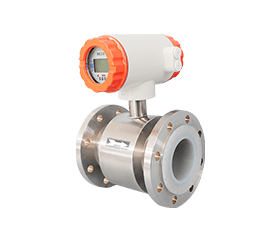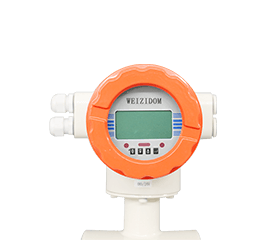Case

Case

Material: Stainless steel or carbon steel (lined with insulating material)
Function: Ensures insulation between the fluid and electrodes, providing a uniform magnetic field environment.
Operating Modes: DC excitation, low-frequency rectangular wave excitation (mainstream)
Power Consumption: Typical value ≤20W
Material: 316L stainless steel, Hastelloy, titanium, tantalum, etc.
Impact on Accuracy: An electrode diameter error of +0.1 mm increases measurement deviation by 1.2%.
Key Parameters: Temperature resistance -20°C to 180°C; Pressure resistance 0.6 to 4 MPa
Mainstream Materials: PTFE (corrosion-resistant), rubber (cost-effective)
Function: Converts microvolt-level induced electromotive force into a standard 4–20 mA signal
Response Time: ≤0.5 seconds (high-speed models up to 0.1 seconds)
Operating Principle: Industrial Application of Faraday’s Law of Electromagnetic Induction
E=k×B×D×v E: Induced electromotive force (V)
k: Instrument constant B: Magnetic flux density (T)
D: Pipe diameter (m) v: Average fluid velocity (m/s
Magnetic Field Generation: Current passes through the excitation coils, creating a magnetic field perpendicular to the fluid flow within the measuring tube.
Electromotive Force Generation: The movement of the conductive liquid cuts through the magnetic lines of force, inducing an electromotive force between the electrodes.
Signal Processing: The processor converts the electromotive force signal into a flow velocity, which is then used to calculate volumetric flow rate based on pipe diameter.
Compared with orifice flowmeters, they reduce pumping energy consumption by 15%–20%.
Typical turndown ratio of 10:1 (can be up to 1000:1).
Capable of measuring complex media containing solid particles (≤70% concentration) and fibers.
Application: Monitoring the flow of raw water, sewage, and sludge.
Advantages: Corrosion-resistant liners (rubber, PTFE) adapt to impurities and chemicals; no moving parts minimize clogging.
Application: Measuring corrosive media (e.g., sulfuric acid, alkaline liquids) or high-purity pharmaceutical liquids.
Advantages: Electrodes and liners available in corrosion-resistant materials (e.g., PFA, tantalum); meet sanitary standards (e.g., 3A certification).
Application: Filling and process control of conductive liquids like juice, milk, and beer.
Advantages: Hygienic design (Tri-clamp connections), easy cleaning, preventing contamination.
Application: Monitoring slurry, tailings, and smelting waste fluids.
Advantages: Wear-resistant liners (e.g., ceramic, polyurethane) suitable for high-solid-content fluids and high-wear environments.

Application: Measuring water injection and crude oil with high water conductivity.
Advantages: High-pressure designs (up to PN40) adaptable for long-distance pipelines; resistant to oil-gas mixture interference.
Application: Monitoring circulating cooling water, boiler feed water, and desulfurization slurry flow.
Advantages: High accuracy (±0.5%), bidirectional flow measurement, integrated communication protocols (e.g., HART, Modbus) for remote control.
Minimum conductivity requirement: ≥5 μS/cm (standard models).
Unsuitable for: oils, gases, ultrapure water (<1 μS/cm).
Liner materials determine temperature resistance (rubber: -20°C to 80°C, PFA: -40°C to 180°C).
Typical pressure ratings: PN10–PN40.
Full Pipe Condition: Install vent valves if necessary.
Grounding: Ground resistance <4Ω; avoid sharing ground with large motors.
Because based on Faraday’s law, the liquid must be conductive to cut the magnetic lines of force and induce an electromotive force. Conductivity must generally be ≥5 μS/cm (e.g., tap water is around 50–500 μS/cm).
No. Gases are non-conductive, and oils typically have conductivity below the threshold unless they contain sufficient water or additives.
Yes. Standard models withstand -20°C to +120°C (high-temperature models up to +180°C); pressure resistance is typically ≤PN40 (4 MPa), higher with special designs.
Ensure a full pipe by installing vertically (flow upwards) or horizontally (electrodes on the sides).
Straight pipe sections: upstream ≥5D, downstream ≥2D.
Proper grounding is crucial to prevent electromagnetic interference.
Possible causes:
Pipe not full (presence of bubbles or empty pipe)
Electrode contamination or scaling
Low liquid conductivity
Poor grounding or power interference
Solutions: Check pipeline conditions, clean electrodes, verify conductivity, re-ground the system.
Bubbles: Large amounts may cause signal fluctuations or underestimation. Ensure a full pipe and install vent valves.
Solid Particles: If particles are uniformly suspended and the liquid is conductive, there is generally no impact; select wear-resistant liners.
Liner Materials: PTFE for strong acids/alkalis; PFA for high-temperature corrosion.
Electrode Materials: Tantalum for hydrochloric acid, Hastelloy for sulfuric acid, titanium for seawater.
Chemical Cleaning: Soak in dilute hydrochloric acid or specialized cleaners (ensure power is off).
Mechanical Cleaning: Use ultrasonic cleaning or a soft brush (avoid scratching electrodes).
Symptoms: Abnormal fluctuations in measurements, zero-point drift.
Inspection: Visual check after disassembly or water test for insulation performance.

Depends on diameter, materials, and features:
Small diameters (DN15–50): approx. RMB 2,000–8,000
Large diameters (above DN200): RMB 10,000–100,000
Special materials (e.g., tantalum electrodes, ceramic liners) are more expensive.
Advantages: Higher accuracy (±0.5%), better resistance to bubble interference, no need for long straight pipe runs.
Disadvantages: Only suitable for conductive liquids, higher cost, requires cutting into the pipeline for installation.
Yes. Explosion-proof models (Ex d IIC T6) are available for flammable and explosive environments (e.g., chemical plants, oil fields).
Requirements:
Material: 316L stainless steel housing, PTFE/PFA liners
Structure: Tri-clamp connections, no hygienic dead angles
Certification: 3A, EHEDG, or FDA standards
Check:
Ensure power voltage is normal (usually 24VDC)
Check if terminals are loose or short-circuited
Verify if the signal is locked or incorrectly set in the menu.
Common protocols: HART, Modbus RTU, Profibus PA/DP, Foundation Fieldbus (FF); some models support wireless transmission (e.g., LoRa).